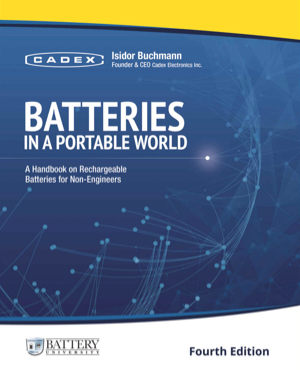Discover the power of the “smart” battery when making historic performance data visible
A new frontier is opening that allows downloading historic data from a “smart” battery to estimate battery state-of-health (SoH) based on field events. While smart batteries have been around for 20 years, none displays relevant SoH information in an easy-to-read format that battery users understand.
SMBus is the most commonly used protocol for portable batteries. It stores embedded data, configures the charger, measures delivered energy and estimates capacity, also known as absolute state-of-charge. The information can be read in seconds, is within +/-5 percent of the true capacity derived from a full discharge cycle and includes other characteristics such cell balance, calibration status and battery age.
The SMBus battery shows state-of-charge (SoC) but one of the limitations of is hiding SoH. This could be for simplicity reasons; it could also be a deliberate attempt to conceal such information in fear of complications if the battery were to deliver less than 100 percent capacity during the warranty period. (See BU-601: How does a Smart Battery Work?)
The SoC reading alone is not complete without also knowing how much energy the battery can hold at any given time in the life of the battery. By nature the fuel gauge always shows 100 percent after each charge, even if the capacity has dropped in half. This gives a false sense of security as the condition of the battery is unknown. Although called “smart,” the SMBus battery behaves much like a “black box” that does not communicate well to the outside world.
The Open Battery Test Architecture (OBTA™) by Cadex gives the SMBus battery a voice by revealing historical data to the battery user. Figure 1 suggests the display showing the battery capacity together with the adjustable pass/fail threshold. SoC is shown in a circle; internal resistance, calibration cell balance and age can also be check-marked. More detailed information is shown on subsequent screens.

Figure 2: Display of key SMBus data that lead to battery evaluation.
Capacity, the leading health indicator, is shown with the set pass/fail threshold that can be adjusted according to risk factor. The battery is Good when meeting all SMBus parameters.
If a battery anomaly occurs, the color of the indicator turns from green to red and the deficiency is spelled out. Battery errors can often be corrected with a full discharge/charge cycle; non-reversible faults, such as capacity fade, elevated internal resistance and cell imbalance spell the end-of-battery-life.
OBTA™ in a Network
OBTA™ can be built into a battery charger or analyzer and one of the special features is sharing the SMBus data in the cloud. With each charge or analysis, the battery file is updated. Its whereabouts is known and the retirement scheduled before the capacity drops below a set threshold that would compromise risk. This information can also be made available on mobile devices.
OBTA™ can dispatch Tier 1 batteries for critical uses while packs reaching the end-of-life may continue to service in less critical applications. Only batteries that have faded below a usable capacity or exhibit irreversible deficiencies are replaced. This allows full service of each battery, reducing costs and lowering environment concerns. OBTA™ also reduces the number of medical devices sent for repair as well-managed batteries fail less often.
OBTA™ helps Biomed Techs budget for new batteries by listing packs that are nearing replacement. The database can also record the “spare” capacity that is left after a mission before charge. An analogy is the fuel in an aircraft if landing was delayed. The spare will assist in finding the sweet spot to set the pass/fail threshold that involves risk management and economy. Table 2 lists data of batteries that can be made available from a common source.
| Serial Number | Model | Location | Last Service | Capacity at full SoC | Spare before chg. | Target capacity | Error Code |
|---|---|---|---|---|---|---|---|
| M-1234 | Medica | East Wing | 20150707 | 95% | 35% | 80% | N/A |
| P-7890 | Heartbeat | Emergency | 20150630 | 88% | 24% | 80% | Calibrate |
| ABC-567 | Pulsestart | Surgery | 20150508 | 82% | 15% | 80% | N/A |
Table 2: OBTA™ database keeps SoH and other information on each battery
OBTA™-compatible battery analyzers can also be configured to generate labels that are attached to the battery and address a specific user group, identify a high risk application, mandate the frequency of testing or assign a contact person in case of irregularity.
Battery maintenance saves money and the cost savings were demonstrated in a 340-bed hospital in the USA. When the need to replace batteries for patient monitors came to $56,000 based on the date-stamp method, the supervisor objected and requested that the packs be checked with a battery analyzer. This revealed that most packs were still in good condition and the budget was reduced to $11,000.
The need to improve battery management was reflected in a US FDA survey that reported “up to 50 percent of issues in hospitals are battery related.” Meanwhile, DOE discovered that every year roughly one million lithium-ion batteries are discarded with most packs having a capacity of up to 80 percent.
Biomedical Technicians are aware of frivolous battery replacements, declaring that with proper care modern batteries can be kept for five years. Said a Biomed Tech, “Batteries, I would say, are the most abused components in hospitals. Staff care little about them and only do the bare minimum. Recommendations for battery maintenance are vague and hidden deep inside service manuals.”

